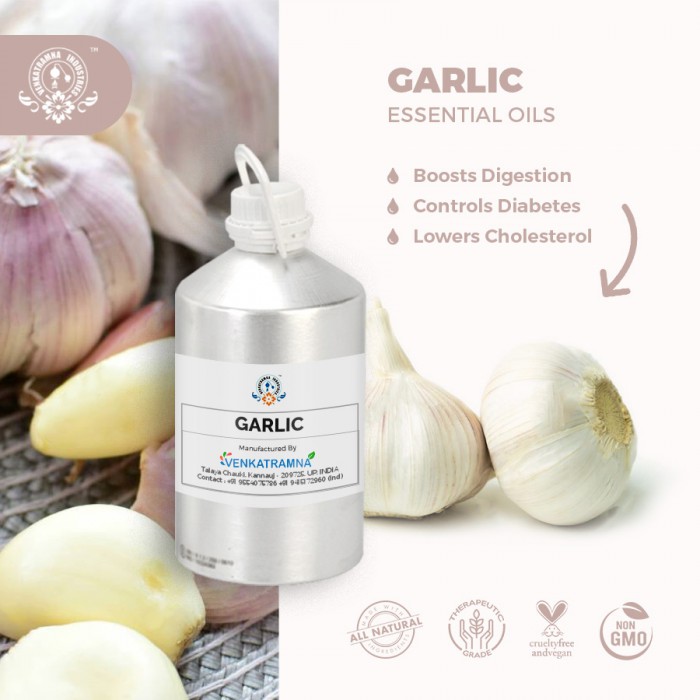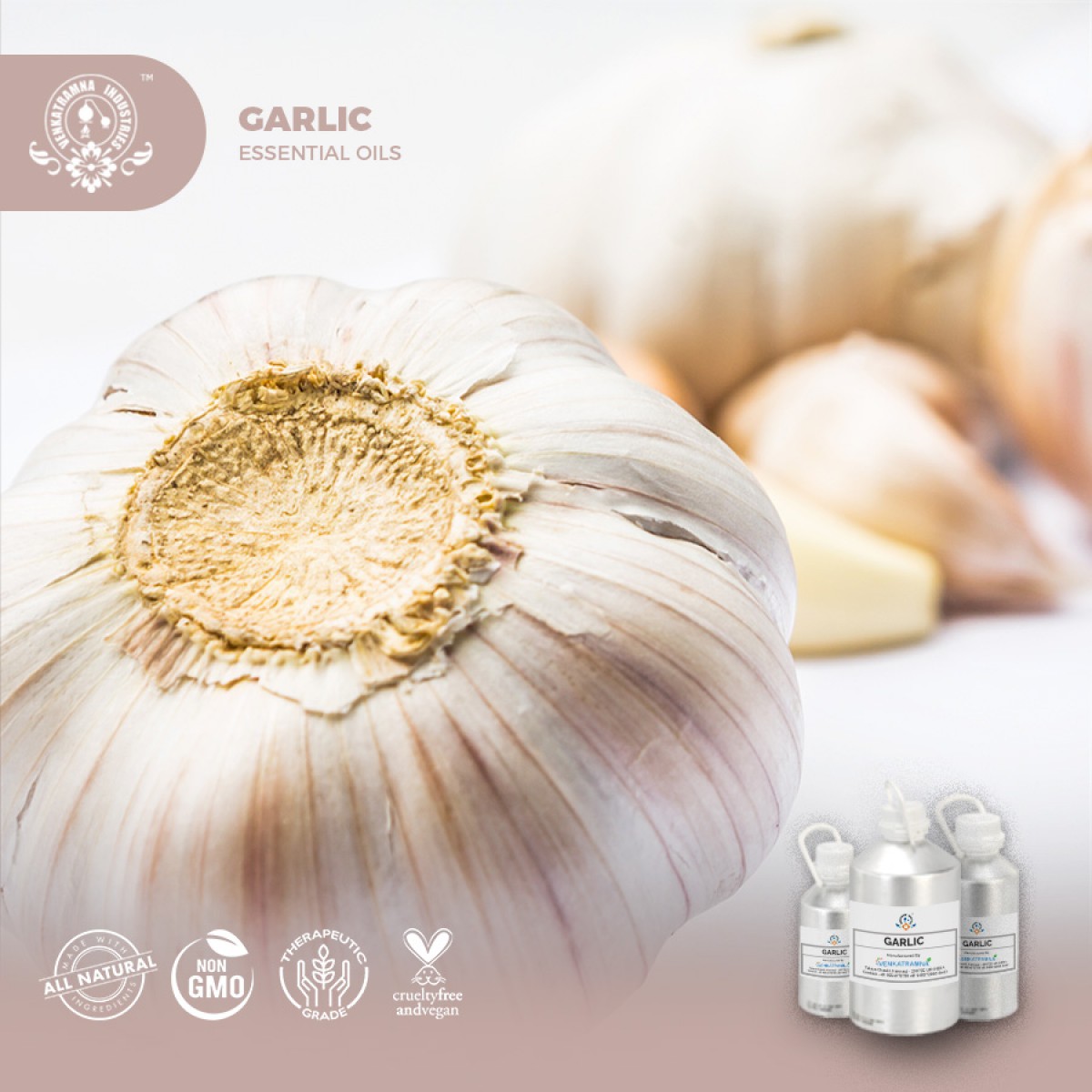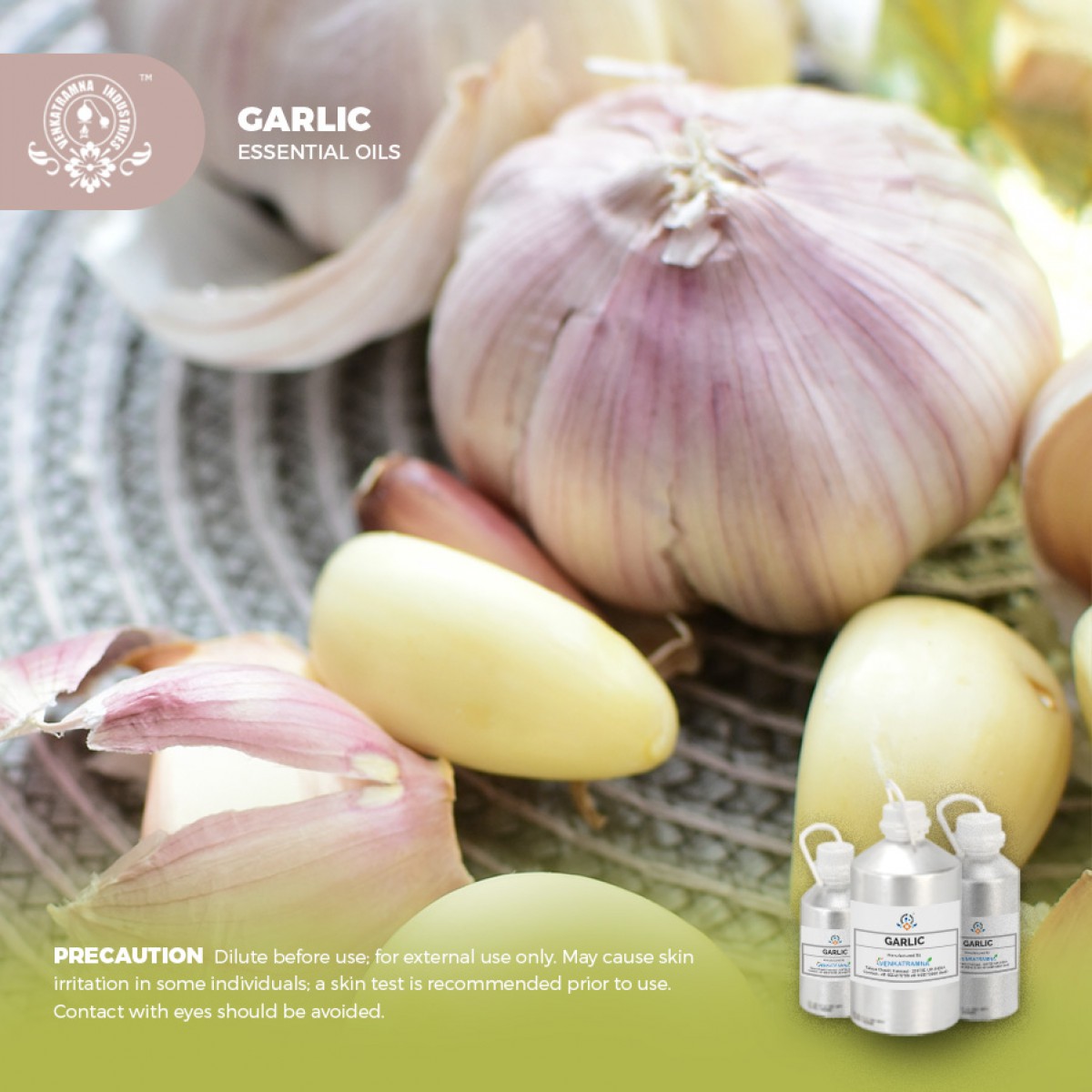Botanical Name: Allium sativum Common name: Garlic, Lahsan, Plant fam Read More
|
Botanical Name: |
Allium sativum |
|
Common name: |
Garlic, Lahsan, |
|
Plant family: |
Liliaceae |
|
Genus: |
Allium |
|
Appearance/Color: |
Pale yellow to reddish orange clear liquid |
|
Odor: |
A top note of strong aroma, Garlic Essential Oil has a very
strong and pungent aroma of garlic. |
|
Blends With: |
Asafoetida, Basil Sweet, Chili, Cumin and Rosemary. |
|
Origin: |
India |
|
Source: |
Bulb |
|
Method of
Extraction: |
Steam Distillation |
Allium sativum, known as
garlic, is a strongly aromatic bulb crop believed to originate from Kazakhstan,
Uzbekistan, and Western China. A. sativum was domesticated long ago and is
mentioned in ancient Egyptian, Greek, Indian, and Chinese writings. Garlic
grows in temperate and tropical regions all over the world, and many cultivars
have been developed to suit different climates. A. sativum is the
most widely consumed bulb after onion.
Allium sativum is divided
into two subspecies, A. sativum var. sativum, also known as softneck
garlic, and Allium sativum var. ophioscorodon, also known as hardneck
garlic. Both varieties are composed of an underground bulb made up of cloves,
which are prophylls enclosed by dry membranous skins and held together by a
basal plate. The variations differ in that hard neck garlic’s bulb is composed
of six to eleven cloves, circled around a centralized woody stalk. This variety
of garlic has a scape that curls at the top, but it is generally removed after
it curls one to three times. This is because if it continues to grow, less
energy can be utilized towards the bulb. Eventually, the scape would give rise
to bulbils, containing miniature cloves. The bulbils are occasionally
accompanied by white or light purple flowers, although these are sterile. Softneck
garlic does not have a flowering top and contains up to twenty-four cloves per
bulb.
Garlic has been traditionally used to treat a wide variety of ailments, including bacterial and fungal infections, intestinal worm infestations, wounds, diarrhea, rheumatism, diabetes mellitus, cardiovascular diseases (thrombosis, hypertension, hyperlipidemia), metabolic disorders and others. Today, this plant is included in traditional medicine in most cultures. Garlic, available in various formulations for medicinal purposes has also been used to relieve symptoms caused by cancer and benign prostatic hypertrophy. However, in all the applications listed, clinical evidence in support of these uses is very weak or is absent. Popularly is also used or has been used in the past as mosquito repellent, anti-catarrhal, for hoarseness and as a sedative for cough. Topical application of garlic is used traditionally to treat skin warts.
DISCLAIMER
The complete range of conditions
or methods of use are beyond our control therefore we do not assume any
responsibility and expressly disclaim any liability for any use of this
product. Information contained herein is believed to be true and accurate however,
all statements or suggestions are made without warranty, expressed or implied,
regarding accuracy of the information, the hazards connected with the use of
the material or the results to be obtained from the use thereof. Compliance
with all applicable federal, state, and local laws and local regulations
remains the responsibility of the user.
The FDA has not evaluated the
statements on this website. No claims are made by Venkatramna Industries as to
the medicinal value of any products from vriaroma.com or by us. The information
presented here is for educating our customers about the traditional uses of
essential oils and is not intended to diagnose, treat, cure, or prevent any
disease. You are responsible for understanding the safe application of these products.
If you have any questions, please call or email us for further information.
As per NAHA guidelines, New Directions Aromatics
(NDA) does not recommend the ingestion of essential oils. It is imperative to
consult a medical practitioner before using Essential Oils for therapeutic
purposes. Pregnant and nursing women and those taking prescription drugs are
especially advised not to use this product without the medical advice of a
physician. The oil should always be stored in an area that is inaccessible to
children, especially those under the age of 7.
Garlic has a long history of
medicinal use for a wide variety of conditions and was once known as the poor
man's treacle. Garlic as a rich source of bioactive compounds and as a folk
medicine for the treatment of various diseases. In folk medicine, garlic has
been used internally to treat bronchitis and respiratory problems,
gastrointestinal problems, flatulence, leprosy, menstrual cramps, high blood
pressure, and diabetes, and externally for warts, corns, arthritis, muscle
pain, neuralgia, and sciatica. Although garlic is best known for its culinary
and medicinal uses, it can also be used in homemade cosmetics and crafts such
as garlic braids and wreaths.
Garlic Essential Oil in Pharma
Garlic has pharmaceutical effects
and used to cure a vast conditions including blood pressure and cholesterol,
cancer, hepatoprotective, anthelmintics, anti-inflammatory, antioxidant,
antifungal and wound healing, asthma, arthritis, sciatica, lumbago, backache,
bronchitis, chronic fever, tuberculosis, rhinitis, malaria, obstinate skin
disease including leprosy, leucoderma, discoloration of the skin and itches,
indigestion, colic pain, enlargement of spleen, piles, fistula, fracture of
bone, gout, urinary diseases, diabetes, kidney stone, anemia, jaundice,
epilepsy, cataract and night blindness. Garlic products are used as sources of
medicine in many ways in human beings in their day today life. As a result,
researchers from various disciplines are now directing their efforts towards
discovering the medicinal values of garlic on human health.
Essence of Garlic Essential Oil
Garlic is one of the most
important bulb vegetables, which is used as spice and flavoring agent for foods
Garlic adds to taste of foods as well as it helps to make them digestible.
Garlic contains different useful minerals, vitamins and many other substances
used for health of human beings. It is rich in sugar, protein, fat, calcium,
potassium, phosphorous, sulfur, iodine fiber and silicon in addition to
vitamins. It possesses high nutritive value.
COMMON USAGE
·
Boosts digestion
·
Controls diabetes
·
Lowers cholesterol levels
·
Reduces hypertension
·
Eye care
·
Relieves ear aches
·
Treats cold
·
Treats wounds
·
Prevents acne
·
Controls asthma
·
Increase libido
·
Prevents cancer
Ingredients:
|
S.No |
Key Constituents |
Strength (%) |
|
1 |
Diallyl trisulfide |
18.0-48.8 |
|
2 |
Diallyl disulfide |
25.2046.8 |
|
3 |
Meyhyl allyl trisulfide |
8.3-18.2 |
|
4 |
Methyl allyl disulfide |
3.9-12.2 |
|
5 |
Propyl allyl disulfide |
0.26-7.2 |
|
6 |
Methyl allyl tetrasulfide |
0.04-5.9 |
|
7 |
Dimethyl trisulfide |
0.5-3.3 |
|
8 |
Diallyl sulfide |
1.1-2.4 |
|
9 |
Diallyl pentasulfide |
2.1 |
|
10 |
2-vinyl-4H-1,3-dithiin |
0-1.7 |
|
11 |
Methyl allyl pentasulfide |
1.6 |
|
12 |
Dimethyl tetrasulfide |
1.3 |
|
13 |
Propyl methyl disulfide |
0.06-1.3 |
|
14 |
Dimethyl disulfide |
0.4-1.2 |
|
15 |
Diallyl tetrasulfide |
0.5-1.1 |
TOXICOLOGICAL
INFORMATION
Safety Summary
·
Hazards: Moderately toxic; inhibits blood
clotting; skin irritation.
·
Contraindications: (oral) Anticoagulant
medication, hyperthyroidism, major surgery, peptic ulcer, hemophilia, other
bleeding disorders.
Organ-specific effects
·
Adverse skin reactions: Garlic has
frequently been cited as causing ACD. Fresh garlic paste has been the cause of
irritant dermatitis in children; garlic oil has caused similar problems, also
in children. Diallyl disulfide is the most common cause of skin sensitization,
including one case of systemic contact dermatitis. Propyl allyl disulfide and
other allergens, not present in the essential oil, have also been identified.
There are two reports of photoallergic contact dermatitis to diallyl disulfide,
so garlic oil may be photoallergic.
·
Cardiovascular effects: Garlic oil was
hypotensive in humans after oral administration. Garlic oil demonstrates
antiplatelet activity. In six healthy adults it dose-dependently inhibited in
vitro platelet aggregation induced by ADP, epinephrine or collagen. Given
orally to cardiovascular patients at a daily dose of 120 mg for up to 30 days,
garlic oil similarly inhibited platelet aggregation promoted by the same
substances.
Systemic effects
·
Acute toxicity
·
Chronic toxicity
·
Carcinogenic/anticarcinogenic potential
·
Drug interactions
Dilute before use; for external
use only. May cause skin irritation in some individuals; a skin test is recommended
prior to use. Contact with eyes should be avoided.
ECOLOGICAL
INFORMATION
·
Toxicity : Toxic to aquatic life with
long lasting effects.
·
Persistence and degradability: No
Additional Data available.
·
Bio-accumulative potential: No Additional
Data available.
·
Mobility in soil: No Additional Data
available.
Do not allow the material to
enter streams, sewers or other waterways. Dispose of in accordance with local
regulations. Avoid disposing into drainage systems and into the environment.
Empty containers should be taken to an approved waste handling site for
recycling or disposal.





 MSDS-Garlic.pdf
MSDS-Garlic.pdf




